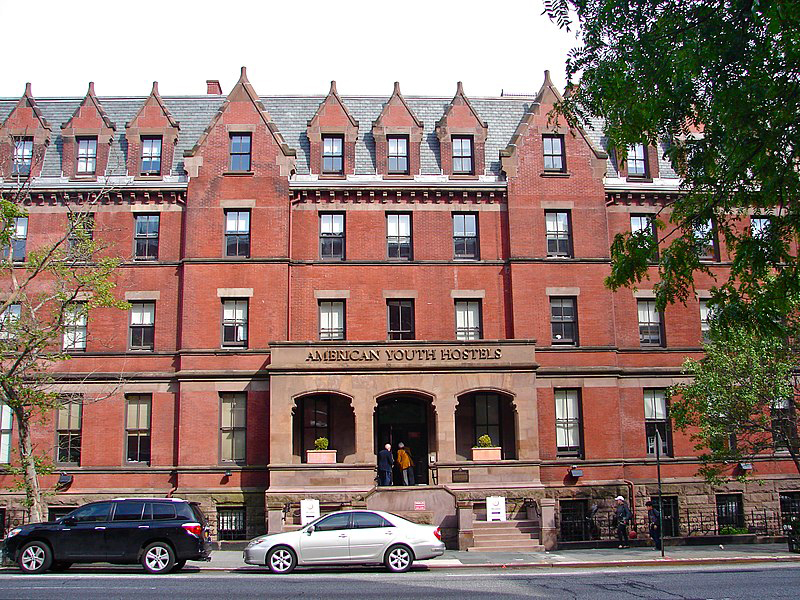
The entrance to HI New York City Hostel today
By Claudie Benjamin
It is the perfect time to celebrate the Victorian building at 891 Amsterdam Avenue. Not so much to mark the building’s 150 + years at this location, but now with the lifting of international travel restrictions into the US, Hostelling International NYC, which has occupied the building since 1999, is looking toward a resurgence of young travelers.
The Association Residence for the Relief of Respectable Indigent Females, was a Protestant-church-affiliated non-for-profit. Its board was composed of socially connected women. The facility first opened in 1838 on East 20th Street. The asylum moved to a newly constructed building 891 Amsterdam (bet. 103rd-104th Streets) in 1873. The building was enlarged in 1907. The mission of the facility was to house elderly women without means to support themselves. Any money they had was given over to the facility into a communal account for the care of residents. If a resident passed, the residence retained the surplus.
These details and many more echoes of history have been shared via articles, lectures and blog posts by Pam Tice. She and her husband Chuck moved to Park West Village in the early 1970s. They engaged in neighborhood activities in a variety of ways. Early on Pam was a VP of the Cathedral of St. John the Divine. During a period in the 1970s when 891 was under threat of demolition, Chuck was involved with the Columbia community of students and neighborhood activists who were successful in a multi-year campaign to save the building. Then, Pam became Executive Director of the international hostel from the time it opened for the next 10 years. “I loved it,” she recalls. She later remained in a volunteer advisory capacity. She is a member of the Bloomingdale Neighborhood History Group and is generally considered an authority in all matters relating to 881 Amsterdam.
Even with her years of connection to this historic building, there are still surprises, along with plenty of memories and rumors associated with this 19th Century building. Call them flights of imagination or ghost stories, one that is particularly evocative is the report several years ago by a night manager that he heard the voice of an old woman requesting a glass of warm milk. This of course points perfectly to the vibe relating to the elderly women who once lived there.
Pam says the facility closed in the 1960s after federal implementation of Medicare and Medicaid programs, safety regulations would have mandated impossibly costly renovations to make the building compliant. Over the years, neighbors who grew up in the area have shared memories about the older women while they were sitting in the courtyard. That outdoor space was originally used for recreation and one level was planted during WWI as a Victory vegetable garden.
Ravaged by fire in the mid-1970s, there are only a few remnants of the building’s original trappings. But, some do remain, the onetime chapel is now the ballroom, available as a rental venue. Mosaic floors with a Grecian geometric pattern in the 1907 addition are still in place, although now covered by carpet. The building’s high ceilings were never lowered and currently ensure air and space for the rooms that are furnished with 600 bunk beds.
There was even a surprise, like a fireplace likely used to heat an original bedroom was uncovered after wall boards were removed during a repair. A rumor that seems credible is that the original pews from the chapel were installed in a local bar that closed before Pam was able to check them out and photograph them. But, she does have slides of the religious-themed Tiffany windows. Originally installed in the asylum’s chapel, the art glass was acquired by the Charles Hosmer Morse Museum of American Art in Winter Park, Florida.
The HI New York City Hostel has always been committed to encouraging international students to become familiar with the community and tours for guests led by the Bloomingdale Neighborhood History Group are expected to resume soon.
